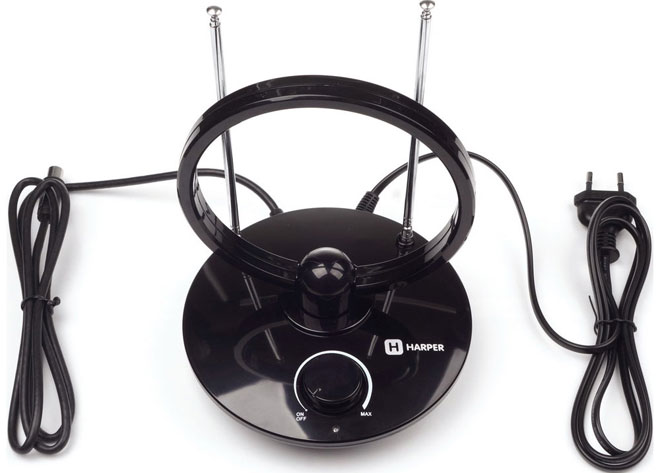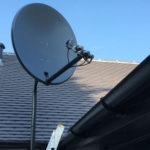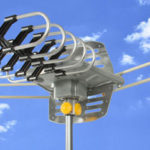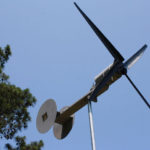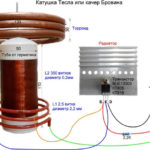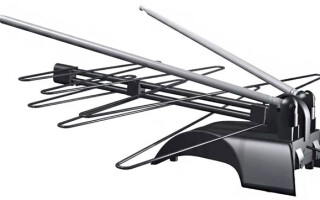Sometimes a television antenna fails at the most inopportune moment, or it simply is not at hand. For example, during a trip to the country. In this case, the question arises of how to make an antenna for a TV with your own hands from what is at hand.
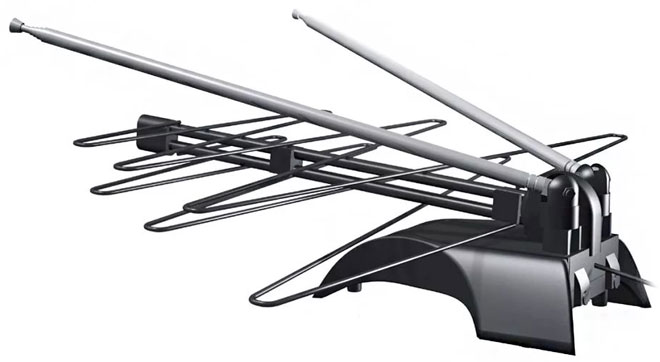
With a homemade transmitter, you can watch a limited number of channels. Yes, and the reception may be of less quality than that of a purchased device. And yet, knowing how to make an antenna yourself from improvised means can come in handy. An antenna can be either simple or complex. The device will be able to receive almost all types of broadcasting.
Antenna types
Before you start making a TV antenna with your own hands, you should understand the types and technical characteristics of television receivers.
Depending on the installation location, indoor and outdoor television receivers are distinguished. Indoor devices are effective only in areas with good signal reception. They are not suitable for country TVs.For rural areas and areas remote from the TV repeater, street TV receivers are used.
According to the type of signal amplifier, television receivers are active and passive. Passive type structures receive and amplify impulses due to their own geometry. They do not need power supply, do not introduce their own interference and noise into the signal they receive. It is easiest to make a passive type antenna yourself.
Active devices are equipped with a signal amplifier, which is powered by the mains. The active amplifier itself creates interference and distortion in the zone of reliable reception in case of choosing too powerful or low-quality device.
Broadcasting is carried out on meter or decimeter waves. For receiving only meter or only decimeter broadcasting ranges, band television receivers are best suited. For example, for the transmission of DVB-T2 digital terrestrial television in our country, only the decimeter range is used.
A log-periodic, or all-wave, television antenna can receive waves of both the meter and decimeter ranges. This is a wideband design with 10 vibrators. The log-periodic device in terms of gain corresponds to a 3-4 element all-wave antenna.
Operating frequencies are limited by the largest and smallest receiver vibrators. It matches well with the feeder. Its gain does not change, so balancing and matching devices are not required to connect to the feeder.
A cable with a resistance of 75 ohms enters the lower tube, exits at the end (which is directed towards the TV center) and is connected by a braid to the end of the lower tube, and the core to the end of the upper tube.
Outwardly and according to the principle of operation, a log-periodic television antenna is several channel-wave devices connected together. Moreover, each of them has its own vibrator, reflector and director. When a signal is received, vibrators are excited that are closest in size to half the wavelength of its wave. Such television antennas are used to receive both digital and analog broadcasts.
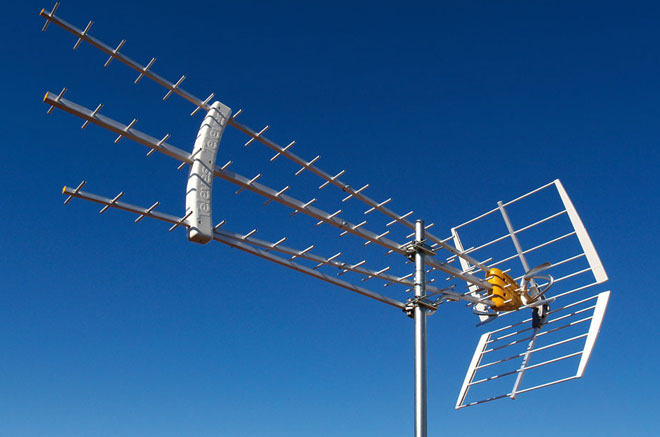
The wave channel receiver has the simplest design, which can be quickly assembled from simple and affordable materials. It receives an analog TV signal near a TV tower and a digital one outside of large settlements, where there is little interference.
We use beer cans
An antenna for giving with your own hands from beer cans is the simplest and most affordable passive type design. It can be done quickly and in the absence of basic skills. At the same time, it copes well with the reception of decimeter broadcasting ranges.
To assemble an antenna from beer cans you will need:
- cable of sufficient length;
- aluminum cans (for the simplest design, 2 is enough);
- 2 bolts or self-tapping screws;
- plug (F - connector) for connecting the cable to the TV;
- electrical tape or tape;
- base made of wood or plastic for attaching cans (you can use wooden hangers for clothes).
The antenna circuit is simple:
- Each can is attached with electrical tape or tape to the base pin at a distance of 7 cm from each other.
- The cable is stripped on one side. They are bred and attached to the rings of cans or to screwed screws. It can also be soldered. A plug is attached to the free end.
This simple design is suitable for installation both indoors and outdoors.For external use, jars are covered with a large plastic container with a cut neck and bottom. The cable is pulled through a hole made on the side, which can be sealed with boiling water. The finished receiver is connected and configured through automatic channel search.
You can also make an analogue of a satellite dish with your own hands. For this purpose, a simple umbrella is used. You will also need:
- aluminium foil;
- copper cable;
- 1 tin;
- amplifier and power supply to it.
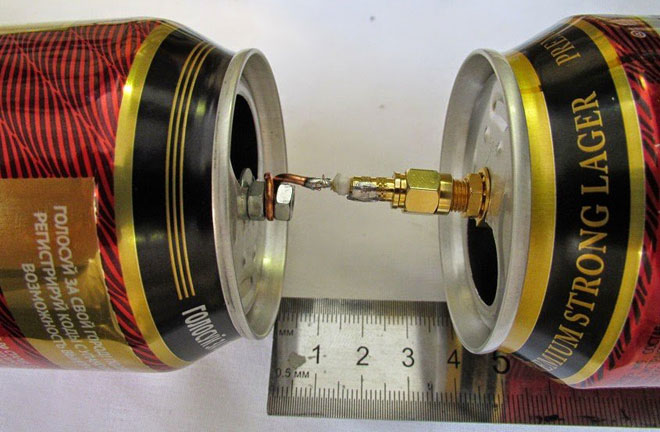
Operating procedure:
- The segments of the umbrella between the spokes are measured and the elements corresponding to these dimensions are cut out of the foil. They are sewn to the dome of the umbrella, covering its entire inside.
- A television signal receiver is installed at the focus of the metal grating. The amplifier will be a core, from which 4 cm of braiding was previously removed, and a cable shield that protects against interference.
- An oval is cut out of an aluminum can. A hole is made in the center of it, through which a bare core is threaded and a contact is soldered. To protect against oxidation and corrosion, the junction is covered with plasticine.
- The amplifier is powered by a cable.
- The receiver is attached to the handle of the umbrella with adhesive tape so that it does not touch the metal. This will protect against interference and distortion. The connection point must be sealed with plasticine.
- The power supply is placed next to the TV, and the antenna is turned towards the repeater.
- Channels are set by operating the dish until the best signal is obtained.
Such an antenna works best if the tower is located no further than 35 km from it.
We use wire
Another simple design is a homemade wire antenna.For its manufacture, you can use copper or brass wire. These materials are resistant to oxidation.
The wire must be stripped from the ends of the insulation. One of them is connected to the TV, and the other - to the battery of the heating system. The pipe is displayed on the roof - it will work as a signal amplifier. Such an antenna can receive no more than 5 signals. The wire can be stretched out onto the balcony and secured to a clothesline.
You can make a TV antenna out of wire in another way. It will require:
- 2 pieces of copper wire 3-4 mm wide and 1.8 m long;
- a plate of plywood or metal measuring 15 by 15 cm;
- amplifier (you can use old decimeter amplifiers);
- electric drill;
- television cable;
- iron pipe or fittings for the manufacture of the mast;
- bolts.
Such a copper wire antenna is assembled as follows:
- Catchers are made, for which they bend the wire in the form of 2 rhombuses with sides of 45 cm. This is the optimal frame length for such a device.
- The resulting rhombuses are fixed on the base. To do this, at the attachment points, flattening the wire, drill holes and screw in the bolts.
- If a metal plate is used as the base, then a welding machine can be used to attach the trap.
- We fix the amplifier in the center and connect the cable to it.
As a mast here, the easiest way is to use a metal pipe, which can simply be dug into the ground or attached to any suitable support. The antenna is fixed at the top of the mast, and the cable is pulled through it. The entire structure is painted to protect against corrosion.
Another popular copper wire television receiver that you can make yourself is a small-sized butterfly antenna of an unusual shape.For external use, such a device is made of wire 2-4 mm thick, for internal use - 2 mm and thinner.
To receive TV channels make a frame. Frame length - 500 mm, width - 200 mm. It is twisted in such a way that 2 identical triangles are obtained, which are separated with wire cutters and soldered to the cable, leaving a 14 mm distance between the vertices. A plug is attached to the other end of the cable. The structure is attached with adhesive tape or electrical tape to a material with dielectric properties - wood, ebonite, plastic.
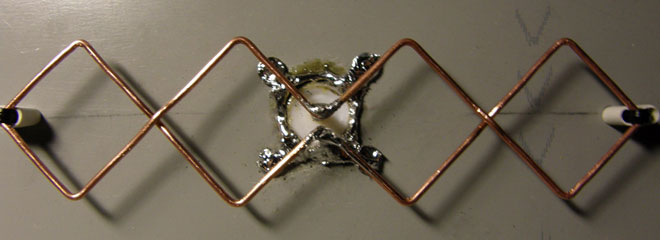
Home Digital HDTV
A powerful TV antenna capable of receiving a 490 MHz signal is made from a transformer, which is better to purchase, since it will not be easy to make it yourself. You will also need:
- cardboard;
- scotch:
- foil;
- stapler;
- glue.
For the manufacture of a television receiver, a scheme is used according to which all parts are cut out of cardboard. Elements are glued with foil, bent and cut. It is best to find the template and diagram first through a search engine and print it on a printer or redraw it from a printed publication.
First you need to make a reflector about 35 cm long and paste over it on one side with foil. In the middle, 2 rectangles of the same size are cut for attaching the trap.
An antenna is assembled from prepared parts. Retreating 35 mm from the reflector, elements of the “butterfly” shape are glued to the plate. They can be attached with a stapler. In the middle of each such element, a hole is made for the cable, to which a transformer is connected and a plug is attached.
Option for an apartment
You can make an antenna for indoor use in any of the above ways.
Another simple option at home is made as follows.
A simple do-it-yourself loop indoor antenna is made of copper wire or a cable with foil in the winding. The device not only receives television channels, but also performs the function of a selective anti-interference filter.
To calculate the size of the loop, you need to know the frequency of the wave for a given region. The length of the loop will be equal to the product of the coefficient (300 units) and the average frequency range.
Cut off the required amount of wire or cable, if necessary, clean the edges. They fold a loop out of it and solder the TV cable leading to the receiver. A plug is attached to it.
The design can be hung or installed on a stand. This simple device, with accurate calculations, is most effective for digital television.
A reliable device for the home is a diamond-shaped antenna. She is the simplest representative of zigzag television receivers. To improve reception, it is equipped with capacitive inserts and a reflector.
The device is assembled from plates or tubes 1-1.5 cm wide made of brass, copper or aluminum. For the manufacture of capacitive inserts, foil, tin or metal mesh is used, which are soldered around the perimeter. The cable is laid from the center and on one side, avoiding sharp bends. It must not leave the frame.
